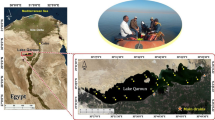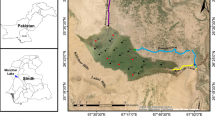Abstract
Lake Burullus is one of the most important coastal lakes in Egypt, as it participates with a considerable amount of fish yield in Egypt. Despite its importance, it is considered as a vulnerable lake, since it is subjected to significant environmental changes caused by various anthropogenic activities. Severe deterioration of its water quality status, as well as a decrease in its water area, has been noticed throughout the last four decades. The main objective of this study is to evaluate the ability of remote sensing for assessing the water quality status of the lake for the period from August 2010 to August 2013. Remote sensing technique was used to retrieve and predict the lake water quality parameter records through the assessment period (August 2010 to August 2013). Stepwise multi-linear regression technique was used to correlate between the field measurements of water quality parameters and the reflectance of remote sensing imageries, and then the derived models were validated. The results revealed the critical status of water quality conditions of the lake, particularly of its southern and southeastern parts. The results showed also that some water quality parameters (Chl-a, TSS, pH, Fe, Zn, Cr, and NH4) can be retrieved from remote sensing imageries with reasonable accuracy (R2 = 0.86, 0.67, 0.65, 0.63, 0.62, 0.61, and 0.6, respectively), while the water quality parameters, which can be predicted, based on calibrated and validated regression models are TSS and Chl-a, with acceptable accuracy (R2 = 0.6 and 0.43, respectively). Lake Burullus needs urgent plans and strategies to protect its water quality from the potential hazards of human activities. The study proved the ability of remote sensing as an effective technique to monitor the changes in water quality conditions of shallow coastal lagoons and to predict with some water quality parameters without field measurements; therefore, it is highly recommended to be used by decision makers.





Similar content being viewed by others
Explore related subjects
Discover the latest articles, news and stories from top researchers in related subjects.Data availability
The data that support the findings of this study are available from The Egyptian Environmental Affairs Agency (EEAA), but restrictions apply to the availability of these data, which were used under license for the current study, and so are not publicly available. Data are however available from the authors upon reasonable request and with permission of EEAA.
References
Abayazid H, Al-Shinnawy I (2012) Coastal lake sustainability: threats and opportunities with climate change. IOSR J Mech 155:33–41
Ali (2007) The exploitation of remote sensing products to improve water quality monitoring in the Nile delta. Vrije universiteit Brussel
Ali E (2011) Impact of drain water on water quality and eutrophication status of Lake Burullus, Egypt, a southern Mediterranean lagoon African. J Aquat Sci 36:267–277
Allan MG, Hicks BJ, Brabyn L (2007) Remote sensing of water quality in the Rotorua lakes
Alparslan E, Aydöner C, Tufekci V, Tüfekci H (2007) Water quality assessment at Ömerli Dam using remote sensing techniques. Environ Monit Assess 135:391–398
Baban SM (1993) Detecting water quality parameters in the Norfolk Broads, UK, using Landsat imagery. Int J Remote Sens 14:1247–1267
Batur E, Maktav D (2018) Assessment of surface water quality by using satellite images fusion based on PCA method in the Lake Gala, Turkey. IEEE Trans Geosci Remote Sens 57:2983–2989
Chander G, Markham BL, Helder DL (2009) Summary of current radiometric calibration coefficients for Landsat MSS, TM, ETM+, and EO-1 ALI sensors. Remote Sens Environ 113:893–903
Chavez PS (1996) Image-based atmospheric corrections-revisited and improved. Photogramm Eng Remote Sens 62:1025–1035
Dekker A, Zamurović-Nenad Ž, Hoogenboom H, Peters S (1996) Remote sensing, ecological water quality modelling and in situ measurements: a case study in shallow lakes. Hydrol Sci J 41:531–547
Dekker AG, Donze M (1994) Imaging spectrometry as a research tool for inland water resources analysis. In: Imaging spectrometry—a tool for environmental observations. Springer, pp 295-317
Dewidar K, Khedr A (2005) Remote sensing of water quality for Burullus Lake, Egypt. Geocarto Int 20:43–49
EEAA N Egyptian Environmental Affairs Agency (EEAA) and the National Institute of Oceanography and Fisheries (NIOF). (2020) http://www.eeaa.gov.eg/en-us/topics/water/lakes.aspx. Accessed 20 September 2020
El-Adawy A, Negm A, Elzeir M, Saavedra O, El-Shinnawy I, Nadaoka K (2013) Modeling the hydrodynamics and salinity of el-burullus lake (nile delta, Northern Egypt). J Clean Energy Technol 1:157–163
El-Din MS, Gaber A, Koch M, Bahgat RSAI (2013) Remote sensing application for water quality assessment in Lake Timsah, Suez Canal. Egypt J Remote Sens 1:61–74
El-Masri B, Rahman AF (2006) Estimation of water quality parameters for Lake Kemp Texas derived from remotely sensed data Project 2006TS224B has resulted in no reported publications as of FY2006
El Saadi AM, Yousry MM, Jahin HS (2014) Statistical estimation of Rosetta branch water quality using multi-spectral data. Water Sci 28:18–30
El Tohamy W, Aziz N, Ghobashy A, Alzeny A (2014) Water quality assessment of Burullus Lake using multivariate analysis. World J Fish Mar Sci 6:564–572. https://doi.org/10.5829/idosi.wjfms.2014.06.06.86180
Elshemy M, Khadr M (2015) hydrodynamic impacts of egyptian coastal lakes due to climate change—example Manzala Lake. In: In: eighteenth international water technology conference. IWTC18 Sharm ElSheikh, Egypt
Erener A, Yakar M (2012) Monitoring Coastline Change Using Remote Sensing and GIS Technologies. Lecture Notes Inform Technol 30:310–314
Farag H, El-Gamal A (2011) Assessment of the Eutrophic Status of Lake Burullus (Egypt) using Remote Sensing. Int J Environ Sci Eng (IJESE) 2:61–74
Frihy OE, Dewidar KM (1993) Influence of shoreline erosion and accretion on texture and heavy mineral compositions of beach sands of the Burullus coast, north-central Nile delta. Egypt Mar Geol 114:91–104. https://doi.org/10.1016/0025-3227(93)90041-S
GAFRD (2009) General Authority for Fisheries Resources Development. http://www.gafrd.org/. Accessed 15 Aug 2015
Han L, Jordan KJ (2005) Estimating and mapping chlorophyll-a concentration in Pensacola Bay, Florida using Landsat ETM+ data. Int J Remote Sens 26:5245–5254
Harris Geospatial Solutions (previously Exelis VIS) (2015) Environment for Visualizing Images (ENVI). http://www.harrisgeospatial.com. Accessed 2 July 2015
Hellweger F, Schlosser P, Lall U, Weissel J (2004) Use of satellite imagery for water quality studies in New York Harbor Estuarine. Coastal Shelf Sci 61:437–448
Hereher M, Salem M, Darwish DH (2010) Mapping water quality of Burullus Lagoon using remote sensing and Geographic Information System. J Am Sci 7:138–143
Hinton J (1991) Application of eigenvector analysis to remote sensing of coastal water quality. Int J Remote Sens 12:1441–1460
IBM A Statistical Package for the Social Sciences. (2019) https://www.ibm.com/analytics/spss-statistics-software. Accessed 22 September 2019
Isenstein EM, Park M-H (2014) Assessment of nutrient distributions in Lake Champlain using satellite remote sensing. J Environ Sci 26:1831–1836
Khalil M, El-Dawy F (2002) Ecological survey of Burullus Nature Protectorate: fishes and fisheries MedWetCoast. Global Environmental Facility (GEF) and Egyptian Environmental Affairs Agency (EEAA), Cairo, p 69
Kjerfve B (1994) Coastal lagoons. Elsevier Oceanogr Series 60:1–8
Lillesand TM (2002) Combining satellite remote sensing and volunteer Secchi disk measurement for lake transparency monitoring. In: Proceedings: National Monitoring Conference, National Water Quality Monitoring Council. pp 1-11
Liu Y, Islam MA, Gao J (2003) Quantification of shallow water quality parameters by means of remote sensing. Prog Phys Geogr 27:24–43
Mohsen A, Elshemy M, Zeidan B (2018) Change detection for Lake Burullus, Egypt using remote sensing and GIS approaches. Environ Sci Pollut Res 25:30763–30771
Moore GK (1980) Satellite remote sensing of water turbidity/Sonde de télémesure par satellite de la turbidité de l'eau. Hydrol Sci J 25:407–421
Morel A (1980) In-water and remote measurements of ocean color. Bound-Layer Meteorol 18:177–201
Morel AY, Gordon HR (1980) Report of the working group on water color. Bound-Layer Meteorol 18:343–355
Mushtaq F, Nee Lala MG (2017) Remote estimation of water quality parameters of Himalayan lake (Kashmir) using Landsat 8 OLI imagery. Geocarto International 32:274–285
Nelson SA, Soranno PA, Cheruvelil KS, Batzli SA, Skole DL (2003) Regional assessment of lake water clarity using satellite remote sensing. J Limnol 62:27–32
Okbah MA, Hussein NR (2006) Impact of environmental conditions on the phytoplankton structure in Mediterranean Sea Lagoon, Lake Burullus, Egypt. Water Air Soil Pollut 172:129–150
Olet E (2010) Water quality monitoring of roxo reservoir using landsat images and In-situ measurements MS, International Institute for Geo-Information Science and Earth Observation (ITC). ITC, Netherlands
Olmanson LG, Bauer ME, Brezonik PL (2002) Use of Landsat imagery to develop a water quality atlas of Minnesota’s 10,000 lakes. In: Proceedings of FIEOS 2002, Conference/Land Satellite Information IV/ISPRS Commission I
Palacios A, Moreira J, Sanchez E, Ojeda J (1995) Evaluation of different methodological approaches for monitoring water quality parameters in the coastal waters of Andalusia (Spain) using Landsat TM data. EARSeL Adv Remote Sens Volvol 4:215–224
Pattiaratchi C, Lavery P, Wyllie A, Hick P (1994) Estimates of water quality in coastal waters using multi-date Landsat Thematic Mapper data. Int J Remote Sens 15:1571–1584. https://doi.org/10.1080/01431169408954192
Phleger FB (1969) Some general features of coastal lagoons Mem Sim Intern Lagunas Costeras UNAM-UNESCO México
Richards JA, Richards J (1999) Remote sensing digital image analysis vol 3. Springer,
Ritchie JC, Zimba PV, Everitt JH (2003) Remote sensing techniques to assess water quality. Photogramm Eng Remote Sens 69:695–704
Rogers R, Shah N, McKeon J, Smith V (1976) Computer mapping of water quality in Saginaw Bay with LANDSAT digital data
Sameh B, Khalafallah A, Omar M, Khalil MM, Yehia A, Allam M (2015) An integrated field and remote sensing approach for water quality mapping of Lake Burullus, Egypt. Int J 6:15–20
Scaramuzza EM, Gyanesh Chander (2004) SLC gap-filled products phase one methodology
Sharaf El Din E (2019) Enhancing the accuracy of retrieving quantities of turbidity and total suspended solids using Landsat-8-based-principal component analysis technique. J Spat Sci 6:1–20
Somvanshi S, Kunwar P, Singh N, Kachhwaha T (2011) Water turbidity assessment in part of Gomti River using high resolution Google Earth’s Quickbird satellite data. In: Geospatial World Forum. pp 18-21
Theologou I, Patelaki M, Karantzalos K (2015) Can single empirical algorithms accurately predict inland shallow water quality status from high resolution, multi-sensor, multi-temporal satellite data? Int Arch Photogramm Remote Sens Spatial Inform Sci 40:1511
Usali N, Ismail MH (2010) Use of remote sensing and GIS in monitoring water quality. J Sustain Dev 3:p228
USGS U.S. (2015) Department of the Interior U.S. Geological Survey http://earthexplorer.usgs.gov. Accessed 15 August 2015
Wang Y, Yan F, Zhang P, Dong W (2007) Experimental research on quantitative inversion models of suspended sediment concentration using remote sensing technology. Chin Geogr Sci 17:243–249
Waxter MT (2014) Analysis of Landsat satellite data to monitor water quality parameters in Tenmile Lake, Oregon
Wen X-P, Yang X-F (2011) Monitoring of water quality using remote sensing data mining. INTECH Open Access Publisher
Xu H (2006) Modification of normalised difference water index (NDWI) to enhance open water features in remotely sensed imagery. Int J Remote Sens 27:3025–3033
Zhou W, Wang S, Zhou Y, Troy A (2006) Mapping the concentrations of total suspended matter in Lake Taihu, China, using Landsat-5 TM data. Int J Remote Sens 27:1177–1191. https://doi.org/10.1080/01431160500353825
Zingstra H (2013) Lake Burullus: water quality using remote sensing data mining. Centre for Development Innovation, Wageningen
Author information
Authors and Affiliations
Contributions
AM correlated between the remote sensing imageries and the field measurements of water quality and wrote the initial draft of the manuscript. ME obtained the field data from EEAA and the remote sensing imageries from USGS website; moreover, he reviewed the initial draft of the manuscript. The major role of BZ was conceptualization, in addition to reviewing the manuscript. All authors read and approved the final manuscript.
Corresponding author
Ethics declarations
Conflicts of interests
The authors declare that they have no competing interests
Ethics approval and consent to participate
Not applicable
Consent for publication
Not applicable
Additional information
Responsible Editor: Philippe Garrigues
Publisher’s note
Springer Nature remains neutral with regard to jurisdictional claims in published maps and institutional affiliations.
Rights and permissions
About this article
Cite this article
Mohsen, A., Elshemy, M. & Zeidan, B. Water quality monitoring of Lake Burullus (Egypt) using Landsat satellite imageries. Environ Sci Pollut Res 28, 15687–15700 (2021). https://doi.org/10.1007/s11356-020-11765-1
Received:
Accepted:
Published:
Issue Date:
DOI: https://doi.org/10.1007/s11356-020-11765-1




